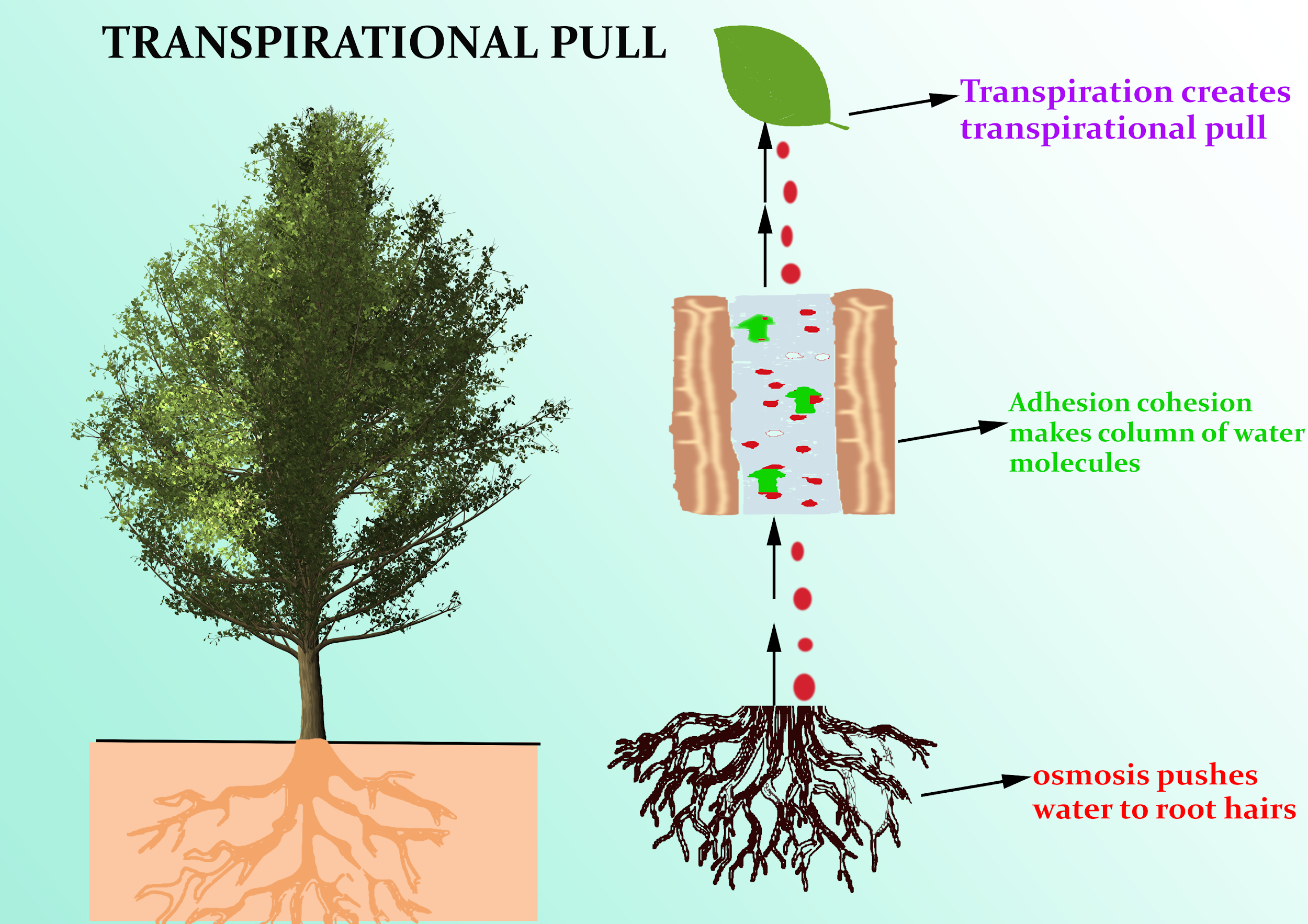
Explain the transpiration pull theory for the ascent of sap.
Answer
500.4k+ views
1 likes
Hint: It is also known as the cohesion-tension theory or cohesion hypothesis. It is mainly based on properties of water molecules, xylem vessels, and forces created due to transpiration. It is a passive process.
Complete answer:
The transpirational pull is the major factor responsible for the absorption of water in plants. The absorption force develops in the shoot or aerial parts of the plant due to the evaporation of water from these surfaces. It is the most rapid method of water absorption in plants and 98% water absorption occurs by this method.
Additional Information:
Transpiration Pull:
A pulling force develops due to transpiration in the xylem column and this is known as transpirational pull. Evaporation of water occurs from the intercellular spaces in leaves, this vacancy of water if filled by mesophyll cells which release more water into the intercellular spaces. Mesophyll cells obtain this water from xylem vessels. Due to this, a tension is created in the water column in the xylem of leaves and this tension extends throughout the whole xylem vessel up to the xylem of roots. This now causes the water to move upwards to the leaves and the whole water column acts as a rope that cannot be broken. So the transpirational pull results in pulling of this rope upwards and to maintain a continuous water column more water gets absorbed by the soil passively by diffusion. Two pathways of water are present, symplast and apoplast.
Cohesion and Adhesion:
This continuous chain of water molecules is maintained due to the cohesion and adhesion forces. The attractive forces that exist between water molecules are known as cohesive forces, this is mainly due to the hydrogen bonds existing between water molecules. The adhesive forces refer to the attraction between water molecules and the wall of xylem vessels.

Note: One problem may arise during the ascent of sap due to transpirational pull, which is the presence of air bubbles which can break the continuous chain of the water column. This is especially seen in larger vessels. When the amount of tension generated is too high then vessels get filled with air bubbles and this phenomenon is known as cavitation. This problem is solved as many vessel columns are present side by side and therefore harmful effects of cavitation are eliminated.
Complete answer:
The transpirational pull is the major factor responsible for the absorption of water in plants. The absorption force develops in the shoot or aerial parts of the plant due to the evaporation of water from these surfaces. It is the most rapid method of water absorption in plants and 98% water absorption occurs by this method.
Additional Information:
Transpiration Pull:
A pulling force develops due to transpiration in the xylem column and this is known as transpirational pull. Evaporation of water occurs from the intercellular spaces in leaves, this vacancy of water if filled by mesophyll cells which release more water into the intercellular spaces. Mesophyll cells obtain this water from xylem vessels. Due to this, a tension is created in the water column in the xylem of leaves and this tension extends throughout the whole xylem vessel up to the xylem of roots. This now causes the water to move upwards to the leaves and the whole water column acts as a rope that cannot be broken. So the transpirational pull results in pulling of this rope upwards and to maintain a continuous water column more water gets absorbed by the soil passively by diffusion. Two pathways of water are present, symplast and apoplast.
Cohesion and Adhesion:
This continuous chain of water molecules is maintained due to the cohesion and adhesion forces. The attractive forces that exist between water molecules are known as cohesive forces, this is mainly due to the hydrogen bonds existing between water molecules. The adhesive forces refer to the attraction between water molecules and the wall of xylem vessels.

Note: One problem may arise during the ascent of sap due to transpirational pull, which is the presence of air bubbles which can break the continuous chain of the water column. This is especially seen in larger vessels. When the amount of tension generated is too high then vessels get filled with air bubbles and this phenomenon is known as cavitation. This problem is solved as many vessel columns are present side by side and therefore harmful effects of cavitation are eliminated.
Recently Updated Pages
Express the following as a fraction and simplify a class 7 maths CBSE

The length and width of a rectangle are in ratio of class 7 maths CBSE

The ratio of the income to the expenditure of a family class 7 maths CBSE

How do you write 025 million in scientific notatio class 7 maths CBSE

How do you convert 295 meters per second to kilometers class 7 maths CBSE

Write the following in Roman numerals 25819 class 7 maths CBSE

Trending doubts
State and prove Bernoullis theorem class 11 physics CBSE

What are Quantum numbers Explain the quantum number class 11 chemistry CBSE

Write the differences between monocot plants and dicot class 11 biology CBSE

1 ton equals to A 100 kg B 1000 kg C 10 kg D 10000 class 11 physics CBSE

State the laws of reflection of light

In northern hemisphere 21st March is called as A Vernal class 11 social science CBSE




